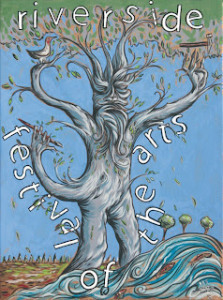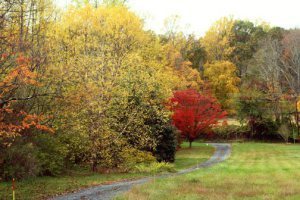Ann E. Michael's Blog, page 76
November 10, 2012
The value of noise
Having posted several times on the value of silence, I feel I ought to balance things out by writing about the value of noise. These thoughts likewise stem from my recent reading: Kay Larson’s book about John Cage, creativity, and Buddhism.
This morning, there were a few hours of intermittent sunshine; the air, still nippy from a recent cold front and some high winds, had warmed up a few degrees. I felt inspired to prune some shrubs and start the rather significant task of removing fallen branches from the lawn. I did not realize how big a job this will be until I started the work because the grass is long and the leaves provide a bit of cover. Every few steps, though, I encountered clumps of twigs, broken branches, sticks of all sizes. We won’t want to run a lawnmower over this mass of debris, and it will get caught in our rakes when we try to remove the leaves. The best way to rid the lawn of storm-downed branches will be the old-fashioned way: human power, gathering one or two sticks at a time. The fresh air streamed into my lungs, the sun shone on my back. I pulled on my husband’s old sweater and my daughter’s old coat and my son’s gloves and my own boots and started to work.
What I noticed this morning was noise. John Cage, a man whose later compositions often engaged with silence, also loved noise. His percussion pieces were scored for tin cans, plates, pipes and modified pianos, and he was prescient about the incorporation of electronically-produced sounds into music. I love reading about his experiments with noise, and today I recognized the music in everyday sounds very clearly.
Today’s noises:
Leaf-crunch. The damp leaves produce difference tones from the dry ones. Leaves of different species vibrate in a range of tones depending upon their thickness, brittleness, serrated shapes, oiliness.
Vehicles. The roads are not terribly close to the house, but when the trees are bare we get a range of vehicle sounds from as far as the highway. Large trucks still growl, wheeze, squeal, rumble, and beep as neighbors get trees removed from their properties and department of transportation crews work at street clean up. Cars drive past.
Somewhere, a leaf-blower. Several chainsaws in the distance.
Mockingbird–not all of them have flown south just yet. The buzzy twittering of starlings and small flocks of sparrows. Woodpeckers drilling at trees.
My breathing.
The sound of the nippers and hedge clippers, the sound that pruned branches make as they whoosh and scratch and shimmy earthward and get tangled in the shrubs. The different noises of a cut made on dead wood and on live wood. The snap of twigs. The silken whisper of long grass underfoot.
Creak and groan of the walnut trees as a stiff breeze hits the woodlot. A dog, barking. The hens, chuck-chucking in their run.
The telephone from inside my house. An overhead jet.
And it isn’t cacophony; it’s a kind of music, certainly. The randomness and the patternedness work together. As do the silences.
Here’s one of Cage’s most melodic works, “In a Landscape,” very apropos … very lovely.
YouTube/John Cage “In a Landscape” Stephen Drury pianist


November 7, 2012
Silence (John Cage, Zen, head-noise)
Slow Muse blogger Deborah Barlow–artist, critic–recommended Kay Larson’s recent book on John Cage, Where the Heart Beats. Silence was so significant in Cage’s work and thinking that, given my recent reflections on noise or lack thereof, this seemed the right time to pick up that text. Lo and behold, synchronicity of several kinds. The author, Kay Larson, thanks John Daido Loori, a rōshi of the Mountains and Rivers order of zen Buddhists and long-time abbot of Zen Mountain Monastery near Woodstock, NY. She studied with him beginning in 1994.
In 1992 and 1993, I attended two weekend retreats there; the brief days remain vivid in my memory. Perhaps more on that another time. Haiku is involved…and silence.
Recently, given some irregular bumps along the walk of life that have led to excessive “head-noise” (my term for stress I can’t quite let go of), I have been returning to some zen-influenced texts and trying to remember to breathe and to be here now. Arne Naess’ writings on joy and environment and Buddhism–I’ve just finished reading a collection of his essays–dovetail very neatly into this reflective book on Cage’s life, work, and influences. Larson’s “Zen” approach to writing about Cage is so gentle and refreshing that reading this book soothes me. I find within myself a kind of inner silence, my breathing returning to its slower, quieter pace, as I read the brief selections of prose Larson uses to explore the life of the mind of this peculiar and innovative artist/composer/writer.
Very like philosophical analogies, Confucian fables, parables of many cultures, koans, meditations, prayer and other forms of contemplative practice.
What reduces head-noise? For me, the best strategy is calmness, but I am not an adept at meditation. I have sat zazen badly, and learned much from the practice of sitting zen badly, but I have never managed to make meditation a genuine practice in my life. Deep breathing and slow movement, such as tai chi or qi gong, seem to work better for me. In addition, the Quiet Place. I settle down better when I can detach from computer, phone, electric lights, appliances. Art reduces head-noise: art requires attentiveness. Poetry, yes. Gardening, walk ing out of doors–good choices. Music, sometimes.
ing out of doors–good choices. Music, sometimes.
Philosophy, not so much. (Alas.)
Politics? Weather reports? Analysis? ….as the Buddhist monks might say: mu. Translation into teen-speak from five years ago: “not.”
And also, compassion. The practice of compassion keeps a person attentive and also relaxed. It is a form of active prayerfulness, of acceptance of self through the acceptance of others. After the bruises and bashings of a presidential election year in 21st-century United States, a little compassion would reduce the malaise and anxiety we have had to endure intellectually, emotionally, and–in the wake of bad storms on the east coast–physically.
I give you Quan Yin, or Guanyin, or Kannon Bodhisatttva, known as Avalokitesvara in Sanskrit and termed the goddess of mercy, a counterpart to the Christian Jesus or Mary. This being represents the compassionate, merciful, kind, non-judgmental, accepting aspect of the cosmos, the universe, or god. I realize that it seems I may have wandered a bit far afield of Cage at this point. But read Larson’s book; I haven’t drifted as far from my topic as it seems.
And just because it does seems as though I am rambling considerably in this post, I think I can close with a poem from my collection Water-Rites, and somehow make it fit with these topics:
Intervention
I am thinking about the cowbirds who fought
in my driveway this morning
and how they struggled, one overbearing the other,
pecking at its head, keeping it pinned
to gravel. I wonder, now, why I chose to stop
and free the losing bird from its aggressor,
lift its bloodied damp body in my hands,
rescue it even though
it was also a cowbird, a pest
that usurps the nests of thrushes—
although I respect the dominion of beak & claw,
I want to preserve the generation
of songbirds; there was no reason for me
to intervene, no logic but somehow I felt
surely there is a place,
in the battle that is this world,
for the mandate of compassion.
© 2012 Ann E. Michael


November 5, 2012
Lost trees
Herewith, some photos of neighboring tree damage. There is an environmental aspect to huge devastating storms…some of my neighbors’ houses have been standing for over 150 years. Some of the trees are 50-90 years old.
Not old by, say, Asian or European standards. But pretty mature and historic for the USA.
New Jersey and Staten and Long Islands were hit much worse, as they also got sea-water surges and flooding. Here, we mostly had tree-down damages. Wires snapped, pulling out transformers and knocking down utility poles and wires.
It was a different type of storm from the ones we experienced last year at around this time (see my post from 2011).
Things are gradually returning to normal. I wish to thank, whole-heartedly, the men (and a few women) who work on the utility and tree crews and who came from all over the USA to help out. Convoys of utility trucks have been greeted with joy by all of us in the mid-Atlantic states. May we never have to return the favor–may you and your loved ones remain safe, sound, and connected! But if you do need help at any time, I hope we can return the favor.


November 2, 2012
Hurricane & silences
Having been through some big hurricanes before, I was prepared as possible for the weather that hit along the MidAtlantic states of the USA (and west to Pittsburgh PA, and north to the New England states).
We are somewhat rural, and we do not have city water or sewer; so if the electricity fails, we lose those modern amenities along with lights and computers and a stove. In Europe, and in newer developments in the US, power lines are more often underground. A wise idea, but not in our current infrastructure at my home.
So weather events–as the news media terms them–are significant to us. They alter our relationship with our house, our land, the earth. That is not necessarily a bad thing. Sometimes, it is pleasant to wake at dawn and hear no humming, no sounds of modern appliances at work. We note, instead, the noise of owls or wind or starlings. The rustle of grasses.
We miss hot water the most. That the well pump isn’t working and the water heater’s not heating: that means our standards of cleanliness necessarily fall. We can get used to it, but we miss it. Cooking on charcoal or a camp stove takes longer but isn’t really a problem for us, however. We can sleep in the livingroom by the fireplace if the cold weather sets in before the electricity comes back on to make the furnace fans operate.
We lost power Monday evening, and since then the human-made sounds are those of vehicles, chainsaws, and generators. And a pleasanter noise: my windchimes.
~
When the winds were very high, I sensed the resolute structure of our house, which did not shudder, though the windows made some alarming sounds–a kind of whistle, a bit of rattling, the occasional thump.
~
Days without electricity take me back ten years when my family spent a week on an island off of Nova Scotia. Our host lived off the grid by necessity–no electricity or plumbing on the island even though it had been inhabited since the mid-1800s. Tides, sunrise and sunset were our time-keepers. The natural sounds were restful and healing.
~
So, too, the kinds of silence I experience when a large tree falls on the powerline, though the sense is less restful because of anxieties over family members, job, and the awareness that there are messes and expenses to deal with once we are reconnected to the 21st century. For a day or two, however, I feel my breath returning to a more animal pace and fullness. I watch things more closely. The line of water droplets beading irregularly under the porch handrail, the grass tassels’ subtle color variations as they move in a breeze, a toad’s progress across the patio slate, a few brilliantly yellow trees that kept their foliage despite the gale.
~
Weather like this is refreshing, my sister says, even if frightening, because people need to be reminded that technology cannot control everything. The hurricane interrupted cell phone use, communication systems, transport networks, traffic, electrical grids. We ended up wet and cold and we needed to take shelter with friends and to share supplies and stories, to wait awhile before we hurry on our way.
~
So here’s irony, that I am using technology to enter these words into a system that keeps them in an electronically-maintained, digitized data ‘cloud’ so people in the Netherlands or Norway, Seattle or Colorado, India or Britain can retrieve and read them…even though my theme is the joy of low-tech lifestyle (for awhile, at least). My power at home is still out, so I am posting these thoughts from a borrowed computer an hour from home; but I composed these thoughts at home, on paper, with a pen, by kerosene lamp. And I will be going back to that quiet, chilly environment later this evening to feed our pets and continue waiting for the valiant and hardworking utility crews to get to our backwater…
~
My reading material during this ‘weather event’ has been The Ecology of Wisdom by Arne Naess, an excellent philosophical companion for study by lamplight. I was struck by his essay “The Place of Joy in a World of Fact” which is so life-affirming. Not playful–Naess is serious about joy–but sensible. Environmentalists need to get out and find joy in the environment, he says, not just focus on the joyless losses. He urges all of us to give up the “cult of dissatisfaction” and promote good causes by example.
“One may say, somewhat loosely, that what we now lack in our technological age is repose in oneself. The conditions of modern life prevent the full development of the self-respect and self-esteem required to reach a stable, high degree of acquiescentia in se ipso [self-acceptance].”
~
What I feel when the power goes off is repose in myself. While it may not reside within me for long, the fact of its appearance–its existence–is gratifying, joyful, powerful. I do not require the fridge, the computer, the lights. I am an animal alive in an animate, changing, living world.
It’s good to be reminded, now and then.


October 25, 2012
Another Reading reading
On All Saints’ Day, November 1st, I’ll be reading poetry in Reading Pennsylvania–again! And this time, I’ll be accompanied by my fellow Goddard alumna, the dynamic and talented Barbara DeCesare, author of Jigsaw Eyesore and Silent Type.
Reading, PA is home to GoggleWorks, a former goggle-making factory that now serves as studio, theater, and gallery space for Berks County area artists and craftspeople of all kinds. Small, struggling cities like Reading are turning to the arts as a means to fill abandoned factory space and create an economic and cultural reason to keep downtown areas alive. Sometimes these efforts succeed, sometimes they don’t. GoggleWorks opened in its current incarnation in 2005. So far, that’s a 7-year run, supported through grants and donations and rent. I am optimistic about GoggleWorks and about other such endeavors, including Bethlehem PA’s Banana Factory, which is a little closer to my neighborhood. I strongly believe the arts belong in our neighborhoods, in our school curricula, and in our lives.
I’m thrilled, therefore, to be reading from my book, Water-Rites, at 6 pm November 1st at GoggleWorks’ Cucina Cafe.
And I’m thrilled to be reading with Barbara, whose work is funny, poignant, imaginative, fierce, and charming by turns.
November 1st is the Day of the Dead in Mexico, a good day for elegies and to celebrate the lives of those we’ve loved and lost. I will be thinking of David Dunn, among other dear ones. And in honor of All Saints’ Day, I may also read a poem or two about saints; recently, I’ve composed a few imaginary lives of saints poems.

http://www.myspace.com/catrinashuesos...
I have no idea what Barbara DeCesare has up her sleeve for this event, but it is certain to be delightful. If you are in the region, stop by at 6 pm. I believe an open mic follows the reading.


October 17, 2012
Place
A family member has recently complained that she wants to move from her apartment because her feelings for the place have changed. It’s been on her mind so much that she seems obsessive about this urge to find a more suitable home, somewhere she feels she can “fit in.” My response, initially, was compassion; then, I began to feel irritated (other people’s obsessions often seem irritating). I’ve been reading essays by the Norwegian philosopher Arne Naess for the past few days, however, and his work has tempered my irritable response. Place matters.
Naess was an originator of the “deep ecology” movement, a follower of Gandhi’s non-violence philosophy, a mountaineer; his influences include Taoism and Spinoza. Deep ecology, as a movement, is fairly controversial and has been subject to some pointed criticism–but as a philosophical practice, its inquiry and premises have been valuable to subsequent thinking and critical problem solving as applied to the earth and its environmental limitations.
What appeals to me about Naess, though, is the personal aspect of his “ecosophy,” a term he coined to refer to earth-wisdom, to place-wisdom. He called his own place-wisdom Ecosophy T: the “T” stands for Tvergastein, a mountain he loved and sometimes chose to live on. Living above the timberline for weeks at a time, Naess observed tiny flowers, diverse lichen forms, changeable and severe weather systems, mice, foxes, herds reindeer bedding down in front of his hut. He contemplated life’s interconnectedness, the concept of peace in all aspects of earth-dwelling, compassion for all sentient beings, respect for earth-forms from rock to plant to insect…

(saxifrage photo–http://torirotsstitches.blogspot.com)
As Buddhist studies say: “When one has great loving-kindness towards all sentient beings, there are limitless beneficial effects.” Naess seems to have believed this whole-heartedly. He loved the mountain, he loved the miniature saxifrages, he loved the view of the valleys and the lake. These things enlightened him about the inherent earth-wisdom of the place itself. All of his thinking seems to spring from the mountain’s earthy source, its seasons. A mountain seems unchanging to most of us, but Naess appreciated its transformations. Such acceptance can lead to an abiding sense of peace and peacefulness, and certainly to a comfortable feeling of belonging to place.
I understand that urge to belong to place. It’s one reason I have stayed in one region for so long: I do not live in an area of breathtaking natural beauty or harsh extremes, as Naess chose to do, but I respond to my surroundings deeply here in the valley. The temperate climate with its four distinct seasons, the plants I recognize, the familiar birds and mammals, insects and toads, salamanders, the gravel and the different soils, the creeks and meadows, the agricultural fields and–yes–the suburban sprawl and nearby highways all make up the place where I exist. It’s comfortable, and it is comforting, and it is always surprising in small ways as I push my observations and attempt to deepen my understanding of and connection with the place I call home.
There have been times I’ve had to leave places that felt like home, and there’ve been times I’ve felt uncomfortable in the place I dwelt. And I needed to move on when that discomfort became too nagging, to irritable to ignore.
So I’m back to my place of compassion again.
Here’s “Urge for Going.”
http://www.youtube.com/watch?v=Z3EofN3Flag


October 9, 2012
Not a dry spell
October arrived in a remarkably ordinary way, considering how inconsistent the weather in my valley has been during the past year. There were a few clear days of brilliant sky, some heavy breezes with leaves beginning to drift into the lawn, a couple of glorious autumn days–mild and crisp–followed by a spate of rain and humid air (and toadstools and mushrooms cropping up everywhere), a further yellowing and reddening of foliage, and then, chilly rain.
This is “normal” weather for our area in early- to mid-October. Although the heavy skies and damp chill are not always welcomed by residents, including me, the gardener in me feels relieved. We need the rain and the coming dormancy. The birds relish the late, large insects that frequent gutters and fields, ponds and puddles, providing proteins for a trip south or for winter ahead. Seeds need the watering-in and the cooling-down. Trees need reminders to store their nutrients deep inside when the cold air really sets in.
And pretty soon, I will have bulbs to plant. I want the soil to be moist enough to dig up and the ground temperature cool enough to keep the daffodils still and quiet for several months.
Some years, I write prolifically in autumn; it’s as though the change in season effects a kind of transition within me, and creativity abounds. Other years, not so much. I do notice that when I spend a good deal of time out in the garden, I write more. This fall has not been that kind of season. I have been busy with writing tasks that do not exercise the philosophical or metaphysical side of myself–though I have been writing, most of the work has been reviews, proposals, pedagogy. I will be posting links to the reviews and essays on the sidebar to the right, adding to the list…
Should fortune–and the Muse–smile upon me, there may be a few new links to poems, as well, in the coming weeks. In November, I’ll be giving a few readings locally. In January, I’ll be teaching Introduction to Poetry again, and I’m eager to try new texts for my students.
Perhaps the post-equinox period will have a creative harvest after all.


September 29, 2012
Rights & responsibilities
I recently assigned a short reflection essay to my freshman college students. The topic was the rights and responsibilities of voting; I asked which mattered more to the student: the right to vote, or the responsibility to vote (or if they were equal in importance). I then requested that they explain their reasoning.
Let’s just say that I didn’t get too many deeply-considered responses, and I could mention that more than one student wrote about ballets instead of ballots.
But before I sigh too deeply or launch into a rant about the lack of interest young people show about governing the country, I must stop myself. After all, these students are 17 and 18 years old. They have not felt engaged in the process of self-governance of any kind–with a few exceptions–including the responsibilities of adulthood in most of its forms. They are still being financially supported by their families. They have meal plans, so they seldom have to go food shopping, budget their dollars and their nutritional needs, or worry about going hungry. They are emerging from the narcissistic and peer-driven teen years and haven’t had much reason to examine public policy or how it affects them. They haven’t learned yet about fallacies, straw men, slippery slope reasoning, ad hominem attacks, circular arguments, and the ways certain uses of rhetoric can persuade us from rational paths.
They do not usually even understand rationality. They are all emotion and denial, but there is an underlying current of curiosity beginning to stir in their souls. Usually.
At least a few of my students, all of whom are “beginning” writers who lack confidence in written expression, produced brief reflections on what rights are and how they differ from personal, cultural, community, or social responsibilities. Even the least reflective students recognized that the Constitutional right to vote is crucial to a democracy; the more adventurous students argued with themselves about how important it is to “vote well” (ie, to be an informed citizen when one casts a vote). A few decided that if a person votes based on looks or culture or without an understanding of the issues or of how our government operates, that citizen is irresponsible, and it would be better if such citizens refrained from voting.
Then, most of these students added that they would not be voting this November, because they are uninformed.
If my classroom is representative, the US presidential candidates have not been effective among the youth vote. There were a number of students, however, who felt that the privilege of voting is so significant that they fully intend to vote in this election (their first ever); and they say they intend to inform themselves of the issues that matter both to themselves individually and to the nation as a whole.
One-fifth of my class plans to vote. Voting turnout usually runs from 36% to 55% nationally–I have looked at several sites and gotten conflicting numbers–so my students indicate a lower-than-average turnout rate. I hope that after they’ve spent four years in college and taken philosophy and marketing and communication and history and criminal justice courses, they will be more likely to participate in the “responsible” part of being a citizen who has the right to vote.
Here’s an amusing interactive site where anyone can learn a thumbnail definition of logical fallacies: http://yourlogicalfallacyis.com/


September 22, 2012
Philosophy & English are friends
At my day job, I do a great deal of tutoring in writing at the college level. Most students who sit down to work with me expect that I will help them learn to use commas and apostrophes, to write thesis statements and to unclutter their sentences. I do that, but the most important part of tutoring writing at the college level is actually rhetoric. One of the things I constantly tell my students is that Philosophy and English are friends.
Many freshmen have no idea why either course is required for a bachelor’s degree. I hope that the ones who find their way to my office for writing help finally understand–however reluctantly–that composing essays and learning critical thinking skills do merit their attention and do, in fact, transfer to whatever set of skills their majors may require of them.
This past week, my sessions featured the “Analysis for Rhetoric” paper and papers for several different Philosophy professors, including essays based upon readings of Garrett Hardin (the famous “Lifeboat Ethics” essay) and Mortimer Adler. Most of the time, I helped my students read rather than write. It isn’t possible to write effectively about a text one does not understand, and rhetorical analysis is new to most college freshmen. Between the not-knowing-how and the not-understanding, most of the student attempts at paper-writing end up weak and wordy.
With no foundation in rhetoric, essay structure disintegrates. Even sentences often operate with a rhetorical function that few 18-year-olds understand until it is pointed out to them: sentences that offer parallels, for example, or if/then speculative structures, or the this-therefore-that causative rhetoric. If the student hasn’t yet figured out how to analyze a text for rhetorical strategies, he or she certainly cannot structure a credible paper about it. What I have learned is that many people know what they want to say but cannot relay it to a reader who isn’t psychic. I have to keep reminding narcissistic young people that, amazingly, the professor does not share their assumptions or “know what they mean.” Sometimes I use Lego blocks to give a visual, concrete example of linking, scaffolding, and therefore building an essay in a fashion the reader can follow.
After years of tutoring, I often do know what the student is trying to say; but I pretend I don’t. If I say it for them, they don’t learn how to say it themselves–and that isn’t teaching.
~
Two excellent books to study regarding how grammar structure relates to elegant writing are Virginia Tufte’s Artful Sentences and Sister Miriam Joseph’s classic work The Trivium.


September 17, 2012
Arts festival
Early autumn is a lovely time for festivals. The city of Easton, PA–situated on the Delaware River–is hosting its 15 annual Riverside Festival of the Arts. There will be music, art shows, food, etc. on September 22 and 23.
At noon on the 23rd, I will be reading poetry with Diane Lockward at the amphitheater. Next to the river: a perfect site to read from my book Water-Rites.
~
The link is here. Or check the Events tab above.










